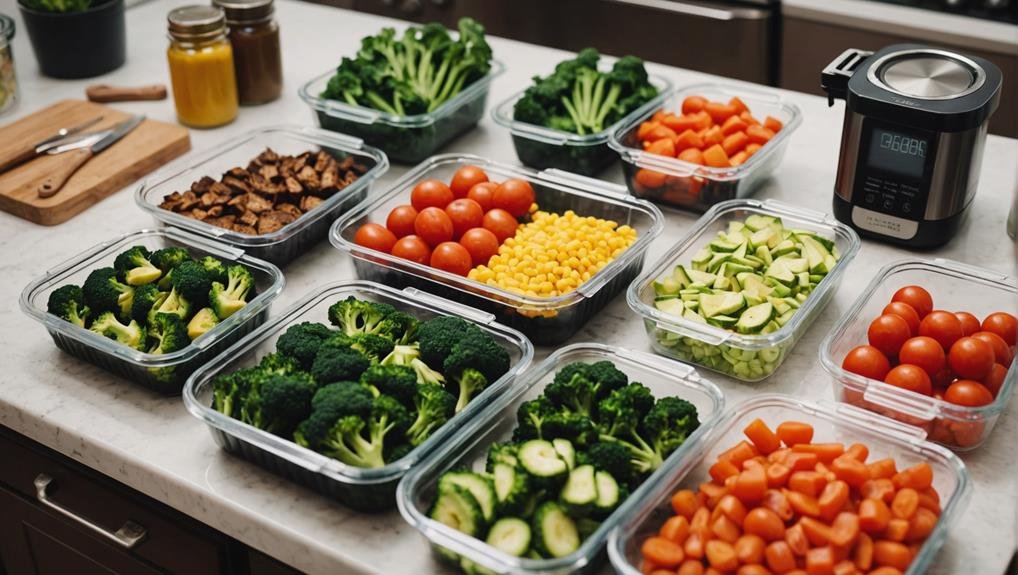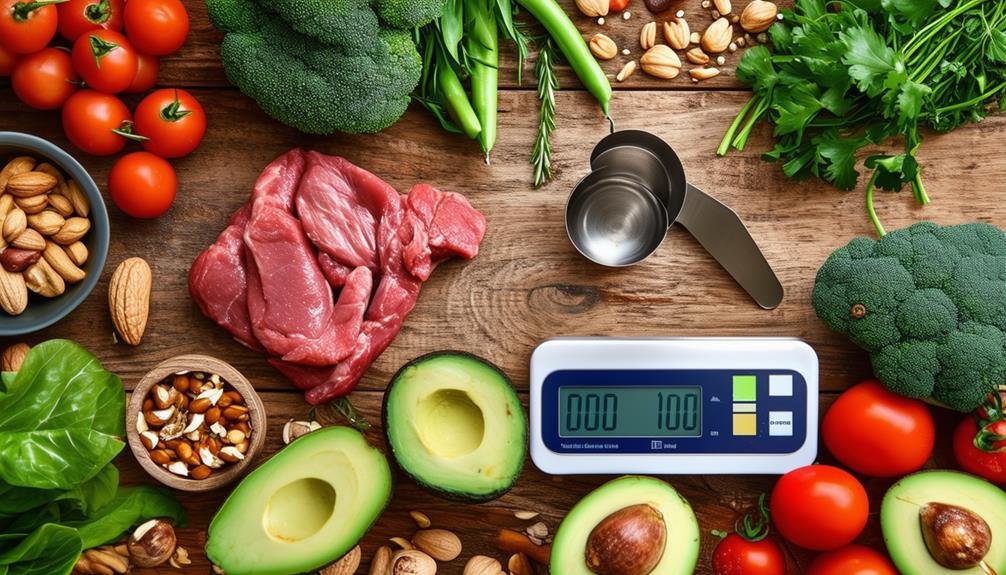Creating a personalized keto diet plan involves meticulously balancing your macronutrient intake. The typical macro distribution for a ketogenic diet consists of 70-75% fats, 20-25% protein, and 5-10% carbohydrates. This ratio is designed to facilitate weight loss and maintain a state of ketosis by prioritizing fat as the main energy source.
It is important to accurately track your macro intake, so utilizing apps like MyFitnessPal can be beneficial for monitoring your consumption. Meal prepping is an effective strategy to adhere to your diet plan and minimize the risk of impulsive food choices.
Furthermore, prioritizing nutrient-dense foods is essential to ensure you meet your micronutrient requirements, which supports overall health. Explore additional strategies to customize your keto experience effectively.
Key Takeaways
- Determine your ideal macronutrient ratios by aiming for 70-75% fats, 20-25% protein, and 5-10% carbohydrates to effectively support ketosis.
- Use keto calculators to customize your macronutrient intake based on your specific goals and activity level for a more personalized approach.
- Focus on nutrient-dense foods such as avocados, low-carb vegetables, and healthy fats to fulfill both your macro and micronutrient requirements.
- Adopt meal prepping techniques to streamline adherence, alleviate cooking stress, and ensure a steady intake of balanced nutrients throughout the week.
Overview of Custom Keto Diet
The Custom Keto Diet is a personalized meal planning program designed specifically for individuals following a ketogenic lifestyle. Created by nutritionist Rachel Roberts, this program streamlines the process of developing a customized meal plan that aligns with your unique health goals and dietary preferences. Upon completing a comprehensive survey, you receive a tailored diet plan that caters to your specific needs.
This personalized approach provides you with clear dietary guidelines, grocery lists, and enjoyable recipes, all while ensuring that the meals are nutrient-dense. A standout feature of the program is its macro distribution, typically advising a breakdown of approximately 70% fats, 25% protein, and 5% carbohydrates. This macronutrient ratio is calculated to effectively support fat loss and enhance overall health benefits.
The Custom Keto Diet also emphasizes the importance of a meal plan that integrates seamlessly with your lifestyle, making it easier to maintain the dietary changes over time. With a starting price of around $37, it's a budget-friendly alternative to traditional nutrition consultations, offering access to personalized dietary strategies without a hefty cost.
Key Macros for Keto Success
To achieve success on a ketogenic diet, it's essential to grasp the ideal macronutrient ratios typically comprising high fats, adequate protein, and minimal carbohydrates.
Consistently tracking your macronutrient intake is crucial for adhering to these ratios; utilizing nutrition apps or reading food labels can enhance your accuracy.
Furthermore, be prepared to modify your macronutrient distribution based on your specific needs and fitness objectives to optimize your results on the keto diet.
Ideal Macro Ratios
Achieving success on a ketogenic diet relies heavily on understanding and adhering to the ideal macronutrient ratios that facilitate your body's transition into ketosis. Typically, these ratios include approximately 70-75% fats, 20-25% protein, and 5-10% carbohydrates. Maintaining this balance is crucial for effective fat-burning and reaching nutritional ketosis.
Here is a reference table outlining the ideal macronutrient ratios:
| Macronutrient | Percentage |
|---|---|
| Fats | 70-75% |
| Protein | 20-25% |
| Carbohydrates | 5-10% |
While these percentages serve as a foundational guideline, it is important to recognize that individual needs can differ based on factors such as body composition, activity level, and personal health objectives. Therefore, consider tailoring your macro intake to align with your specific requirements.
For those new to the ketogenic diet, strictly adhering to these ratios is critical for a seamless transition into ketosis and to optimize fat-burning capabilities. Monitoring your macronutrient intake—especially carbohydrates—is vital, as exceeding your carbohydrate limit can hinder ketosis. Utilizing tools like keto calculators can assist in identifying your specific macro goals, ensuring effective meal planning and adherence to the ketogenic lifestyle.
Tracking Macronutrient Intake
Tracking your macronutrient intake is crucial for maintaining ketosis and adhering to the macronutrient ratios of a ketogenic diet, typically comprising about 70% fats, 25% protein, and 5% carbohydrates.
Proper tracking ensures your calorie intake aligns with your health objectives, whether you aim for weight loss, muscle gain, or overall wellness.
Apps like MyFitnessPal and the Perfect Keto Macro Calculator can simplify the process of tracking your macronutrients. These platforms offer real-time insights into your food intake and help you adjust your targets as necessary.
By regularly monitoring your macro ratios, you can optimize your dietary approach, ensuring your keto meals provide the necessary nutrients while avoiding deficiencies in essential vitamins and minerals.
Maintaining awareness of your macronutrient distribution promotes effectiveness in your diet and helps prevent nutritional imbalances that may result from restrictive eating.
Adopting a systematic tracking method supports your overall well-being while allowing for enjoyable and diverse meal options.
This heightened awareness fosters a more sustainable ketogenic lifestyle tailored to your unique needs and goals.
Adjusting for Individual Needs
Adjusting your macronutrient intake based on personal factors such as activity level and health goals is crucial for optimizing the benefits of a ketogenic diet. The standard macronutrient ratios for a ketogenic diet are approximately 70-75% fats, 20-25% protein, and 5-10% carbohydrates. However, these ratios should be tailored to fit your unique body composition and individual needs.
Utilizing a keto calculator can assist you in identifying your ideal macronutrient ratios by entering information such as age, weight, and activity level. For instance, individuals who are more active may require a greater amount of protein to aid in muscle recovery, whereas those with a sedentary lifestyle might need to reduce their overall caloric intake.
Monitoring your macronutrient intake is essential for adhering to your personalized dietary plan and ensuring you consume the appropriate proportions of each macronutrient.
As you make progress, it's important to regularly evaluate your goals based on the responses of your body to further enhance the effectiveness of your ketogenic regimen. By customizing your intake to reflect your individual requirements, you can not only facilitate weight loss but also promote overall health and well-being throughout your ketogenic journey.
Importance of Meal Prepping

Meal prepping is a vital strategy for anyone adhering to a keto diet, particularly as it can save valuable time during busy weekdays.
By planning your meals ahead of time, you ensure that you consistently choose nutrient-dense options that align with your dietary objectives.
This practice not only streamlines the cooking process but also helps you steer clear of impulse purchases that could hinder your progress.
Time-Saving Strategies
Dedicating just one day to meal prep can significantly enhance your keto journey by saving time and helping you stay on track. By planning your meals for the entire week, you alleviate the daily stress associated with cooking and ensure adherence to your diet plan, which is crucial for effective weight loss.
Meal prep allows you to prepare essential ingredients, such as chopped vegetables and marinated proteins, in advance. By batch cooking keto-friendly meals like low-carb pot roast or stuffed peppers, you create convenient, portion-controlled options for busy days.
Additionally, using a grocery list based on your chosen recipes helps minimize food waste and ensures you have all necessary ingredients on hand.
Incorporating quick, 5-minute prep meals—like Teriyaki Chicken or Korean BBQ Beef—not only adds variety to your menu but also helps meet your macro goals efficiently. These strategies streamline your cooking process, aligning perfectly with the benefits of the keto diet and enabling you to focus on effectively burning carbohydrates.
Ultimately, meal prep is an essential component of achieving success in your nutritional journey.
Nutrient-Dense Choices
Planning nutrient-dense meals in advance is essential for consistently meeting your keto macro goals while enjoying delicious flavors. Meal preparation allows for precise tracking of macronutrients, helping you achieve the recommended keto ratio of approximately 70% healthy fats, 25% protein, and 5% carbohydrates. By incorporating nutrient-dense foods such as avocados, coconut oil, and low-carb vegetables, you can enhance feelings of fullness, which strengthens your adherence to the ketogenic diet.
Dedicate one day each week to meal prep. This strategy not only saves time during hectic weekdays but also helps minimize the urge to deviate from your diet plan. Creating a shopping list based on chosen keto recipes will streamline your grocery trips, ensuring you have all the ingredients required for balanced, nutrient-dense meals that support adequate micronutrient intake.
Varying your selection of keto recipes keeps meals exciting and healthful. Regularly batch-prepping these dishes guarantees an accessible stock of nutritious meals that cater to your tastes. Consistent meal preparation makes it easier to follow your keto plan, ultimately assisting you in reaching your health and wellness objectives without sacrificing flavor or diversity in your diet.
Quick and Easy Keto Recipes
Are you seeking delicious and quick keto recipes? These meals can be prepared in just 5 minutes, making them ideal for your busy lifestyle while helping you meet your dietary targets. Incorporating high-quality proteins and healthy fats is crucial for achieving the right macronutrient balance. Here is a selection of quick keto recipes to consider:
| Recipe | Ingredients |
|---|---|
| Teriyaki Chicken Stir-fry | Low-sugar teriyaki sauce, chicken, mixed vegetables |
| Roasted Garlic Chicken | Chicken, garlic, olive oil |
| Thai Coconut Beef | Beef, coconut milk, lime |
| Korean BBQ Beef | Beef, low-carb BBQ sauce, sesame oil |
| Avocado Salad | Avocado, olive oil, lemon juice |
These recipes emphasize the significance of healthy fats like avocados and olive oil, which not only enhance taste but also promote a feeling of fullness. Regularly experimenting with different quick keto recipes adds variety to your meals, preventing diet fatigue and supporting long-term adherence to your dietary regimen. By focusing on easy meals that feature high-quality proteins such as chicken, beef, and fish, you can effortlessly stay on track with your health goals while enjoying flavorful dishes. Exploring new culinary ideas can motivate you to continue your keto journey, making it more sustainable. Keep this table accessible as a quick reference for fresh ideas that align with your keto diet and require minimal preparation time.
Nutritional Technologies and Tools

Harnessing nutritional technologies and tools can significantly streamline your experience on a custom keto diet, facilitating the tracking of your macronutrient intake and maintaining a state of ketosis. These resources enable you to monitor your food consumption effectively, ensuring adherence to your diet plan. Here's an overview of essential tools:
- Nutritional Apps: Applications such as MyFitnessPal and Perfect Keto Macro Calculator allow for simple tracking of macronutrients and micronutrients. They feature intuitive interfaces to log meals and help you monitor your carbohydrate, fat, and protein ratios effortlessly.
- Meal Planning Tools: These platforms can create grocery lists derived from your chosen recipes, ensuring you have all the ingredients necessary for your keto-friendly meals. This promotes an organized preparation process and minimizes the risk of impulse buys that could sabotage your dietary goals.
- Online Databases: Numerous online resources provide comprehensive nutritional information about various foods, assisting you in making knowledgeable dietary choices. You can quickly search for the nutrient content of different foods to maintain your targeted macronutrient ratios.
- Ketosis Monitoring Tools: Devices such as keto strips and blood ketone meters are useful for tracking your ketosis levels. They provide immediate feedback on the effectiveness of your dietary choices, enabling you to make informed adjustments to your food intake as needed.
Assessing Health Benefits of Keto
The ketogenic diet offers a transformative approach to health by aiding weight loss and promoting overall well-being. This diet induces a metabolic state known as ketosis, whereby the body predominantly utilizes fat as its primary energy source instead of carbohydrates. This transition can lead to effective weight loss as the body efficiently burns stored fat reserves.
The advantages of the keto diet extend beyond just weight management. Studies indicate that this dietary approach may lower blood sugar levels and enhance insulin sensitivity, making it particularly beneficial for those with type 2 diabetes. By stabilizing blood sugar and insulin levels, individuals can mitigate risk factors linked to these health issues.
Cognitive health is another important benefit associated with the ketogenic diet. The brain can utilize ketones as a potent energy source, potentially leading to improvements in mental clarity and cognitive function. Adhering to a ketogenic lifestyle over the long term may also lower the risk of neurodegenerative diseases.
Furthermore, the keto diet has therapeutic benefits for certain medical conditions, particularly epilepsy, where it has been shown to reduce seizure frequencies in patients who don't respond to conventional medications.
It's vital, however, to maintain nutritional balance while following this diet. Long-term adherence may necessitate careful monitoring and supplementation to ensure adequate intake of vitamins and minerals, as the restricted food choices could lead to nutritional deficiencies.
Frequently Asked Questions
What Should My Macro Balance Be on Keto?
On a ketogenic diet, your macro balance usually consists of approximately 70-75% fats, 20-25% protein, and 5-10% carbohydrates. To effectively achieve these ratios, consider using macro tracking tools, implementing meal prep strategies, and being mindful of common keto pitfalls. This approach will help ensure you reach your keto goals successfully.
How Do I Set My Macros for a Ketogenic Diet?
To effectively set your macros for a ketogenic diet, it's important to recognize that about 20% of individuals are able to sustain their weight loss on this regimen. Start by exploring a variety of keto-friendly food options and consider meal prepping to simplify your dietary plan. Adjust your intake by focusing on different macronutrient sources, and make use of a range of delicious keto recipes to help maintain your goal while ensuring you meet your nutrient needs.
What Is the 33 33 33 Macro Split?
The 33 33 33 macro split allocates an equal distribution of carbohydrates, protein, and fats, each comprising approximately 33% of your total daily caloric intake. This balanced approach allows for a diverse range of foods, promotes stable energy levels, and can support overall health. However, there may be common misconceptions surrounding this distribution. It's essential to personalize your intake based on individual goals and needs to achieve optimal results.
What Is the 40-40-20 Macro Split?
The 40-40-20 macro split can effectively enhance your diet by combining the advantages of a low-carb approach with a balanced intake of carbohydrates. This macronutrient ratio consists of 40% carbohydrates, 40% protein, and 20% fats. To optimize your results, utilize macro tracking tools to monitor your intake accurately and to prevent common pitfalls, such as underestimating protein from various sources.
Conclusion
Creating a custom keto diet plan allows you to optimize your macronutrient and micronutrient intake for better health.
Imagine it as drafting a tailored recipe where each component plays a vital role in your wellness journey.
Incorporating meal prepping can simplify the process, while quick and diverse recipes add variety to your meals.
As you delve into the numerous health advantages, consider utilizing various tools and technologies that can support your progress.
This approach will help you navigate the keto diet effectively, tailoring it to meet your individual needs.
